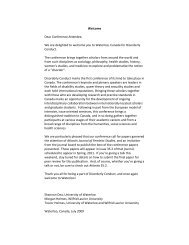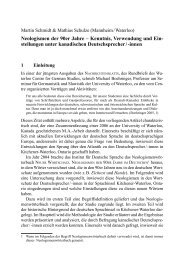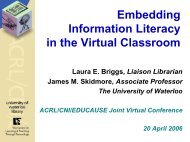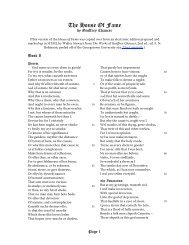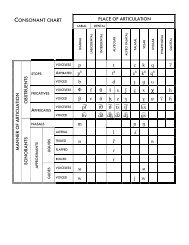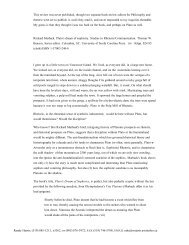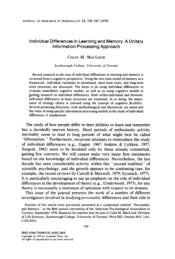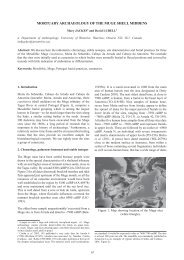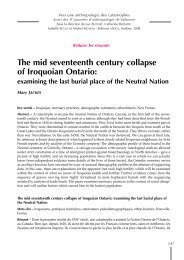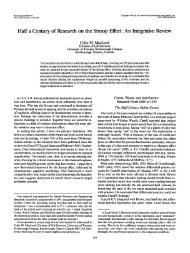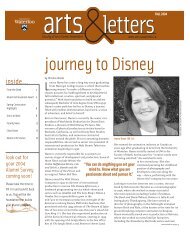Sensed Presences in Extreme Contexts Originally published ... - Arts
Sensed Presences in Extreme Contexts Originally published ... - Arts
Sensed Presences in Extreme Contexts Originally published ... - Arts
You also want an ePaper? Increase the reach of your titles
YUMPU automatically turns print PDFs into web optimized ePapers that Google loves.
<strong>Sensed</strong> <strong>Presences</strong> <strong>in</strong> <strong>Extreme</strong> <strong>Contexts</strong><br />
Orig<strong>in</strong>ally <strong>published</strong> as a review of The Third Man Factor: The Secret of Survival <strong>in</strong><br />
<strong>Extreme</strong> Environments, by John Geiger, Pengu<strong>in</strong>, 2009. 295 pp., $24:00 ISBN 978-0-14-<br />
301751-6 <strong>in</strong> Skeptic 15 (2), 68-71 .<br />
Geiger‟s book is a highly readable compendium of anecdotes about the remarkably common<br />
experience of feel<strong>in</strong>g the presence of a companion for whom there is no objective evidence. The<br />
companion is seldom seen but strongly sensed and hence is often referred to as a “sensed<br />
presence.” The presence is usually taken to be a stranger, but may sometimes be a friend or<br />
mentor, a favorite aunt, a fellow adventurer, sometimes recently deceased, and usually provid<strong>in</strong>g<br />
moral support, guidance, or protection and sometimes described metaphorically, or literally, as a<br />
“guardian angel.”<br />
Approximately three-quarters of the companionate presences discussed appeared <strong>in</strong> the<br />
midst of harrow<strong>in</strong>g misadventures of mounta<strong>in</strong>eers, polar explorers, and sailors. Thus, Geiger‟s<br />
book is about one version of the sensed presence experience, the version that occurs <strong>in</strong> what<br />
Peter Suedfeld has called EUEs; “extreme and unusual environments.” 1 The anecdotes reported<br />
by Geiger are nearly always first-person accounts of the appearance of mysterious, often neutral,<br />
sometimes friendly, and rarely threaten<strong>in</strong>g, presences encountered dur<strong>in</strong>g life-and death struggles<br />
for survival. Indeed, the subtitle of the book implies what is explicitly claimed <strong>in</strong> the book itself;<br />
namely, that the companion is a secret life-saver of either div<strong>in</strong>e or biological provenance. Little<br />
evidence is provided, however, that the companion experience, however comfort<strong>in</strong>g, is more<br />
than a modest aid to survival, let alone the secret to survival.<br />
It should also be noted that there is noth<strong>in</strong>g special about the number three of the title.<br />
The title could have just as justifiably called The Fourth Man, The Second Man, or, <strong>in</strong> at least<br />
one case, The Seventh Person. An early version appears to have been The Extra Man. 2 Geiger<br />
appears to have based his title on the experience of Ernest Shackleton and his two companions<br />
dur<strong>in</strong>g their trek across South Georgia – or to be more precisely accurate, on T. S. Eliot‟s<br />
reference to the event, immortalized <strong>in</strong> “The Waste Land,” with its famous question: “Who is the<br />
third who always walks beside you?” Either through poetic license or misremember<strong>in</strong>g Eliot<br />
reduced Shackleton‟s party from three to two: “When I count, there are only you and I together.”<br />
Elliot‟s notes suggest he was rather vague about his recollection of “the account of one of the<br />
Antarctic expeditions (I forget which but I th<strong>in</strong>k one of Shackleton‟s)”. 3 In the orig<strong>in</strong>al account<br />
of Shackleton, the companion was actually a fourth: “it seemed to me often that we were four,<br />
not three” (p. 37).<br />
One of the most strik<strong>in</strong>g features of the experience of the companion is its elementary<br />
and m<strong>in</strong>imalist properties and the consistency of these across <strong>in</strong>dividuals and circumstances. All<br />
of the germane <strong>in</strong>formation about each and every encounter <strong>in</strong> the text could likely be described<br />
<strong>in</strong> 10-20 type-written pages, and comprehensively summarized <strong>in</strong> one. The bulk of the<br />
approximately 250 pages of text consists of background and context-sett<strong>in</strong>g events lead<strong>in</strong>g up to<br />
the experience itself. The experiences themselves do become very familiar and repetitive, though<br />
<strong>in</strong>terest<strong>in</strong>g variants do crop up from time to time. Although the descriptions of the events lead<strong>in</strong>g
2<br />
up the experiences sometimes went on just a bit too long for my lik<strong>in</strong>g it must be said that they<br />
are, by and large, gripp<strong>in</strong>g tales well told, and, overall, mostly do provide relevant and<br />
<strong>in</strong>formative context for the companion experiences. I expect most people will f<strong>in</strong>d this an<br />
engag<strong>in</strong>g read<br />
Though pass<strong>in</strong>g reference is made to the experiences of monks and sa<strong>in</strong>ts, Biblical tales,<br />
and the Christian notion of guardian angels, most of the anecdotes are modern, spann<strong>in</strong>g a little<br />
over 100 years. Geiger also provides, towards the end of the book, brief overviews of various<br />
psychological and neuroscientific theories of presence experiences. Geiger highlights critical<br />
features of the experience as well as of their precipitat<strong>in</strong>g conditions as he goes along. With<br />
regard to the latter, he mentions the usual suspects: monotony, darkness, barren landscapes,<br />
isolation, cold, <strong>in</strong>jury, dehydration, hunger, fatigue, and fear; all often extreme, persistent, and <strong>in</strong><br />
comb<strong>in</strong>ation and, <strong>in</strong> the case of mounta<strong>in</strong>eers, compounded by lack of adequate levels of oxygen.<br />
The accounts also frequently <strong>in</strong>volve death and <strong>in</strong>jury of real companions. The large majority of<br />
anecdotes come from the experiences of mounta<strong>in</strong>eers, likely because climbers have the largest<br />
proportion of truly harrow<strong>in</strong>g challenges and are often exposed to almost all of the precipitat<strong>in</strong>g<br />
conditions for the companion experiences.<br />
The vivid and compell<strong>in</strong>g nature of the companion experiences, despite their elemental<br />
simplicity, likely cannot be overstated. Such experiences are almost <strong>in</strong>variably described as<br />
utterly compell<strong>in</strong>g; far too vivid and real to be a mere halluc<strong>in</strong>ation; which is usually to imply<br />
that it defies naturalistic explanation. Halluc<strong>in</strong>ations do not, however, constitute the only, or even<br />
most appropriate, naturalistic explanation available. Strictly speak<strong>in</strong>g, the sensed presence does<br />
not fit the def<strong>in</strong>ition of a halluc<strong>in</strong>ation at all, because, by def<strong>in</strong>ition, halluc<strong>in</strong>ations <strong>in</strong>volve<br />
sensory experiences. Rather, the sensed presence of the unseen companion is a delusion; that is, a<br />
compell<strong>in</strong>g feel<strong>in</strong>g that someth<strong>in</strong>g is the case <strong>in</strong> the absence of evidence. Halluc<strong>in</strong>ations may<br />
sometimes accompany delusions. There may be sounds, voices and visions, even physical<br />
contact, though these are all comparatively rare. None are <strong>in</strong>tr<strong>in</strong>sic to the sensed presence itself,<br />
which, by def<strong>in</strong>ition, is devoid of sensory experience. There is, as William Laird McK<strong>in</strong>ley<br />
stated of his Arctic experiences, there is “noth<strong>in</strong>g of the senses <strong>in</strong> it at all, only an awareness” (p.<br />
53). Yet, the same author can say of this <strong>in</strong>sensible presence that “it filled me with an exultation<br />
beyond all earthly feel<strong>in</strong>g” generat<strong>in</strong>g a feel<strong>in</strong>g of the “absolute certa<strong>in</strong>ly of the existence of<br />
God” (p. 54). Yet, though the presence is not necessarily taken to be supernatural, there is often a<br />
dual consciousness associated with the presence <strong>in</strong> which a hard-nosed realist is simultaneously<br />
aware that the presence is not real <strong>in</strong> the normal sense of the term, yet utterly compell<strong>in</strong>g; so<br />
compell<strong>in</strong>g, and persistent, that food may be offered to the presence <strong>in</strong> a casual and automatic<br />
manner.<br />
Geiger notes that halluc<strong>in</strong>ations, though not often part of the presence experience itself,<br />
do sometimes accompany the sensed presence. They tend to be vague and misty apparitions or<br />
command<strong>in</strong>g voices. Rob Taylor, <strong>in</strong>jured dur<strong>in</strong>g his ascent of the Breach Wall of Kilimanjaro,<br />
reported see<strong>in</strong>g a figure and be<strong>in</strong>g able to “make out his form, yet never can I dist<strong>in</strong>guish exact<br />
features.” The form was a human form without the cloth<strong>in</strong>g of a climber but rather “like a dancer<br />
<strong>in</strong> a leotard” (p. 178). Charles L<strong>in</strong>dbergh encountered multiple presences on his famous trans-<br />
Atlantic flight. He described “vaguely outl<strong>in</strong>ed forms, transparent, mov<strong>in</strong>g” <strong>in</strong> the cockpit. Yet
3<br />
despite his ability to describe the presences, however m<strong>in</strong>imally, they actually seemed to have<br />
been out of sight, as he also says: “without turn<strong>in</strong>g my head, I can see them as clearly as though<br />
<strong>in</strong> my normal field of vision” (p. 85). He also wrote that the presences had “voices that spoke<br />
with authority and clearness.” Yet he admitted that “I can‟t remember a s<strong>in</strong>gle word they said”<br />
(p. 87).<br />
Almost always, there is a vague feel<strong>in</strong>g that the presence is there to help <strong>in</strong> some<br />
unspecified way or, <strong>in</strong> the case of temporarily <strong>in</strong>capacitated sailors, like the solo sailor Joshua<br />
Slocum, simply trusted to man their craft. Or it may simply be a feel<strong>in</strong>g that a navigational<br />
decision was made on the implicit advice of the presence. More often, the companions offer<br />
wordless advice, which is typically highly nonspecific, or provides <strong>in</strong>formation and advice of the<br />
sort that the <strong>in</strong>dividual would already know and believe – or hope. The advice is typically,<br />
“Don‟t fall asleep,” “Keep mov<strong>in</strong>g,” and “You are go<strong>in</strong>g to make it.” That is, sensible<br />
commonplace advice that is more reassur<strong>in</strong>g than <strong>in</strong>formative. Nonetheless, this sense of<br />
reassurance is often credited by the <strong>in</strong>dividuals for their survival. This feel<strong>in</strong>g is essentially the<br />
basis for the claim that the presence is the secret to survival <strong>in</strong> extreme conditions. As Geiger<br />
acknowledges, however, we obviously have limited access to negative cases, the stories of the<br />
presences of the non-survivors <strong>in</strong> recovered diaries are obviously rare, though such cases do<br />
exist. 4 Perhaps as many non-survivors as survivors received support and encouragement from<br />
their presences. Alternatively, perhaps the companions of non-survivors gave bad advice.<br />
Moreover, we do not have <strong>in</strong>formation about how many survivors never experienced the<br />
companionate sensed presence. We have essentially one cell of the four-fold table necessary to<br />
draw the functional conclusion.<br />
In one especially <strong>in</strong>terest<strong>in</strong>g and harrow<strong>in</strong>g anecdote of extremity is recounted by climber<br />
Joe Simpson <strong>in</strong> his book Touch<strong>in</strong>g the Void, about his summit<strong>in</strong>g of Siula Grande (not Huascarán<br />
as <strong>in</strong>dicated <strong>in</strong> Geiger‟s book), and the aftermath of an accident dur<strong>in</strong>g descent. This is perhaps<br />
the most compell<strong>in</strong>g evidence for a survival function of a halluc<strong>in</strong>ation, but ironically, not<br />
actually <strong>in</strong>volv<strong>in</strong>g a presence. Simpson‟s recurr<strong>in</strong>g halluc<strong>in</strong>ation was simply a voice <strong>in</strong> his head,<br />
but a compell<strong>in</strong>g and very authoritative one:<br />
The voice was clean and sharp and command<strong>in</strong>g. It was always right, and I<br />
listened to it when it spoke and acted on its decisions. The other m<strong>in</strong>d rambled out<br />
a disconnected series of images, and memories and hopes, which I attended to <strong>in</strong> a<br />
daydream state as I set about obey<strong>in</strong>g the orders of the voice.<br />
Not surpris<strong>in</strong>gly, this description leads Geiger to <strong>in</strong>voke, as Peter Suedfeld had done previously,<br />
Julian Jaynes‟s notion of the bicameral m<strong>in</strong>d. Indeed the quotation above is essentially a<br />
def<strong>in</strong>ition of a bicameral m<strong>in</strong>d at work. Interest<strong>in</strong>gly, Jaynes‟s perennially controversial theory,<br />
of all those discussed by Geiger, is really the only one explicitly directed at expla<strong>in</strong><strong>in</strong>g the<br />
version of the sensed presence covered <strong>in</strong> this book. What Simpson‟s account rem<strong>in</strong>ded me of,<br />
however, was a more current and ma<strong>in</strong>stream theory <strong>in</strong>volv<strong>in</strong>g a dist<strong>in</strong>ction between two levels<br />
of process<strong>in</strong>g always active <strong>in</strong> human cognition. They go by different names, but the cognitive<br />
process that corresponds to Simpson‟s rational and authoritative voice is commonly referred to<br />
as an “executive” or “control” process. Another level of process<strong>in</strong>g, which corresponds to<br />
Simpson‟s jumble of images, memories, and emotions, appears to reflect what are referred to as
4<br />
“automatic” processes, which operate accord<strong>in</strong>g <strong>in</strong> an associative and appropriately named,<br />
“pandemonium mode,” <strong>in</strong> which different impulses vie for attention and execution. There has<br />
been little written about the nature, of the phenomenological component to these two modes<br />
though a little self-reflection will, I th<strong>in</strong>k, uncover a subtle version of Simpson‟s experience <strong>in</strong><br />
our own mundane experiences. In extreme situations – and they do not come more extreme than<br />
that of Simpson‟s descent from Siula Grande – the phenomenology of the two process<strong>in</strong>g<br />
streams may become enhanced, perhaps through a general emergency reaction of the bra<strong>in</strong> of the<br />
sort discussed by Geiger. One can readily see how the sort of experience might lead people who<br />
have experienced extreme circumstances to <strong>in</strong>terpret the voice as that of a guardian angel - or a<br />
god à la Julian Jaynes. Yet Joe Simpson was a self-declared atheist before his Siula Grande<br />
experience and rema<strong>in</strong>ed one afterward and attributes the voice to a “sixth sense” buried deep <strong>in</strong><br />
our evolutionary past, never personify<strong>in</strong>g it but consistently referr<strong>in</strong>g to it merely as “the voice”<br />
or “it.”<br />
Curiously, Geiger fails to mention that Simpson did report sens<strong>in</strong>g the presence of<br />
companions dur<strong>in</strong>g a period of absence of the voice toward the end of his ordeal. He felt that he<br />
was be<strong>in</strong>g followed closely by two companions, who “hung back out of sight,” and whom he<br />
imag<strong>in</strong>ed to be other members of the expedition, Simon and Richard, who were actually at the<br />
camp ahead of him. He reported that he was happy at the thought of “company and help if I<br />
needed it.” In contrast to the positive guidance of the voice, however, the presences appear to<br />
have been merely comfort<strong>in</strong>g.<br />
I have long been fasc<strong>in</strong>ated by how the most subtle feel<strong>in</strong>gs of presence can conv<strong>in</strong>ce a<br />
McK<strong>in</strong>ley of the absolute certa<strong>in</strong>ty of God‟s existence and the much more dramatic experiences<br />
of a Joe Simpson elicited no spiritual gloss at all. Perhaps most <strong>in</strong>structive is the fact that, despite<br />
his condition of serious <strong>in</strong>jury, fatigue, hypothermia, starvation, and dehydration (at the end of<br />
his ordeal he weighed 90 pounds), Simpson, upon first hear<strong>in</strong>g “the voice” immediately and<br />
systematically considers alternative hypotheses. Did he leave on his Walkman? Were the sounds<br />
the result of his balaclava rubb<strong>in</strong>g on his ears? Geiger concludes that ancient people, lack<strong>in</strong>g<br />
Walkman-type hypotheses, fell back on religious hypotheses. Yet Geiger need not have gone<br />
back to ancient peoples. His own book is filled with numerous examples of moderns <strong>in</strong>vok<strong>in</strong>g<br />
religious or mystical <strong>in</strong>terpretations. It does seem reasonable, nonetheless, to suppose that<br />
moderns have a greater range of possible <strong>in</strong>terpretations and this must, one would suppose, make<br />
a difference <strong>in</strong> the way experiences are perceived. Yet this is clearly, as the Simpson and<br />
McK<strong>in</strong>ley contrast illustrates not the only, or even the ma<strong>in</strong>, story.<br />
Geiger discusses but does not focus particularly on the supernatural, though, judg<strong>in</strong>g<br />
from the reviews beg<strong>in</strong>n<strong>in</strong>g to appear on the web, these sorts of phenomena are magnets for<br />
those <strong>in</strong>vested <strong>in</strong> the occult and spiritual. Geiger cites Michael Murphy as claim<strong>in</strong>g that many of<br />
these experiences “defy easy explanation,” by which he means naturalistic scientific<br />
explanations. Geiger also briefly falls <strong>in</strong>to this casual sophistry describ<strong>in</strong>g the physiologist<br />
Pugh‟s explanations as dismissive. Why commentators so often consider scientific explanations<br />
“easy” or “dismissive” has never been clear to me; especially when I then read of Murphy<br />
claim<strong>in</strong>g that these experiences are evidence that “humans can <strong>in</strong>deed perceive disembodied<br />
entities” (p. 78). Now that strikes me as an easy explanation.
5<br />
One set of naturalistic theories Geiger reviews favorably are those that suggest that the<br />
sensed presence is a biological mechanism for copy<strong>in</strong>g with lonel<strong>in</strong>ess <strong>in</strong> only children <strong>in</strong> the<br />
form of “imag<strong>in</strong>ary companions,” and for adults alone under threaten<strong>in</strong>g and fearsome<br />
conditions. On this view, the sensed presence provides an imag<strong>in</strong>ary companion to relieve<br />
anxiety. One can see how this could be functional – avoid<strong>in</strong>g despair and giv<strong>in</strong>g up – but it does<br />
raise another question. If it is biological, which would entail affect<strong>in</strong>g the relative availability of<br />
neurotransmitters and somatic hormones, why does it need a phenomenological or experiential<br />
component? Why are bra<strong>in</strong> mechanisms not arranged to just make us feel less threatened and<br />
more optimistic without the spooky experience to confuse us? I realize that this is a rather<br />
generic argument regard<strong>in</strong>g consciousness, but it all seems a rather Rube Goldberg contraption to<br />
have evolved just to make us feel comfortable <strong>in</strong> extreme environments.<br />
Perhaps the companion experience is not functional at all, <strong>in</strong> itself, but rather is an<br />
anomalous dissociation that provides evidence of a deeper, more general, function on which its<br />
own functionality, if any, is parasitic. Perhaps, for example, the feel<strong>in</strong>g of presence is simply a<br />
misfir<strong>in</strong>g of normally functional sensations associated with real companions.<br />
Hav<strong>in</strong>g done some trekk<strong>in</strong>g and climb<strong>in</strong>g <strong>in</strong> the Himalayas and the Andes, I am<br />
somewhat familiar with the experience of spend<strong>in</strong>g long hours mov<strong>in</strong>g <strong>in</strong> s<strong>in</strong>gle file. One has a<br />
constant sense of companions ahead and beh<strong>in</strong>d, as well as a sense of dependency on them.<br />
There is the constant rem<strong>in</strong>der of the rope <strong>in</strong> the downhill hand b<strong>in</strong>d<strong>in</strong>g one to the other. Frank<br />
Smythe, for example, specifically notes that it “seemed that I was tied to my „companion‟ by a<br />
rope” (p. 48). Though Smyth was alone, if he had had a companion they would have been tied<br />
together. The rope is truly a life-l<strong>in</strong>e. When a comrade falls, the others dig <strong>in</strong> with ice axes and<br />
crampons and brace themselves to break the fall of the other. Thus, there is both a strong<br />
expectancy of the others to be constantly at a regular distance, ma<strong>in</strong>ta<strong>in</strong><strong>in</strong>g appropriate tension<br />
on the rope, and to be available for assistance. One also f<strong>in</strong>ds oneself periodically look<strong>in</strong>g over<br />
one‟s shoulder to check on the others; even though one knows and feels that they are there<br />
without look<strong>in</strong>g. As noted, <strong>in</strong> the large majority of cases, the presence is just out of sight, often a<br />
couple of meters beh<strong>in</strong>d. Although the presence is described as guid<strong>in</strong>g and encourag<strong>in</strong>g, it is<br />
usually follow<strong>in</strong>g beh<strong>in</strong>d rather than lead<strong>in</strong>g.<br />
The sense of the presence of others is pervasive and cont<strong>in</strong>uous when one is with others;<br />
but we rarely remark on it because, after all, there really are others present and this is the normal<br />
feel<strong>in</strong>g when they are there. We feel it explicitly when <strong>in</strong> <strong>in</strong>tense relationships and acutely when<br />
<strong>in</strong> love; but mostly it is just the reassur<strong>in</strong>g background feel<strong>in</strong>g of companionship. Our feel<strong>in</strong>g<br />
corresponds with recent memory and with current sensory experience. When this feel<strong>in</strong>g<br />
becomes disconnected from what we know from recent memory and current experience,<br />
however, we may then have the experience of the sensed presence. If so, then the presence<br />
experience parallels the “feel<strong>in</strong>g of know<strong>in</strong>g” someth<strong>in</strong>g as a separate experience from the actual<br />
know<strong>in</strong>g of it that we have all experienced as the tip-of-the-tongue experience. In both cases,<br />
background becomes foreground. This is not to dismiss or trivialize either experience, but to<br />
attempt to turn a mystery <strong>in</strong>to a potentially solvable problem; namely, how does this normal<br />
feel<strong>in</strong>g of be<strong>in</strong>g with others become dissociated from what we know from memory and current<br />
sensory experience? This, <strong>in</strong> turns, suggests the possibility that there is a separate set of cognitive<br />
and neural events constitut<strong>in</strong>g the feel<strong>in</strong>g of presence, over and above those that register the
6<br />
sensory experiences generated by the actual presence of others. Perhaps this feel<strong>in</strong>g reflects a<br />
mode or psychological context of “be<strong>in</strong>g with others,” br<strong>in</strong>g<strong>in</strong>g our social selves <strong>in</strong>to prom<strong>in</strong>ence<br />
and act<strong>in</strong>g appropriately and refra<strong>in</strong><strong>in</strong>g from act<strong>in</strong>g <strong>in</strong>appropriately <strong>in</strong> the presence of others.<br />
F<strong>in</strong>ally, <strong>in</strong> extreme situations the need for companions activates the feel<strong>in</strong>g of presence. This<br />
would certa<strong>in</strong>ly be comfort<strong>in</strong>g <strong>in</strong> extreme and unusual environments and, to that extent, could be<br />
construed as <strong>in</strong>cidentally functional.<br />
The Third Man Factor is an engag<strong>in</strong>g book, full of adventure, especially of<br />
mounta<strong>in</strong>eer<strong>in</strong>g (the cover appropriately portrays two figures walk<strong>in</strong>g along a ridge high above<br />
the clouds). Over 40% of all cases cited <strong>in</strong>volve experiences <strong>in</strong> mounta<strong>in</strong>s. Regardless of<br />
differ<strong>in</strong>g titles, many chapters have a feel<strong>in</strong>g of familiarity. One chapter, entitled “The Widow<br />
Effect,” is 37 pages long but has slightly less than five pages devoted to the sensed presence<br />
experiences of widows (and a widower). The rest of the chapter is devoted ma<strong>in</strong>ly to more<br />
mounta<strong>in</strong>eer<strong>in</strong>g adventures. Nonetheless, I do confess that I f<strong>in</strong>d the mounta<strong>in</strong> climb<strong>in</strong>g stories to<br />
be much more gripp<strong>in</strong>g than stories about griev<strong>in</strong>g widows. From my perspective, Geiger has<br />
performed a most valuable service by pull<strong>in</strong>g all of these accounts together <strong>in</strong> s<strong>in</strong>gle volume<br />
provid<strong>in</strong>g a good reference source for modern examples of the companion version of sensed<br />
presence phenomena. I expect I will refer back to this book many times <strong>in</strong> the future.<br />
JAC<br />
1 Suedfeld, P. & Mocell<strong>in</strong>, J. S. P. (1987). The sensed presence <strong>in</strong> unusual environments.<br />
Environment and Psychology, 19, 33-52.<br />
2 Suedfeld, P. & Geiger, J. (2008). The sensed presence as a cop<strong>in</strong>g resource <strong>in</strong> extreme<br />
environments. In J. H. Ellens (Ed.) Miracles: God, Science, and Psychology <strong>in</strong> the Paranormal.<br />
Vol. 3. London: Praeger.<br />
3 Eliot, T. S. Collected Poems: 1909-1962, Notes on “The Waste Land – What the Thunder<br />
Said.”<br />
4 Op. Cit. Suedfeld & Mocell<strong>in</strong>.



